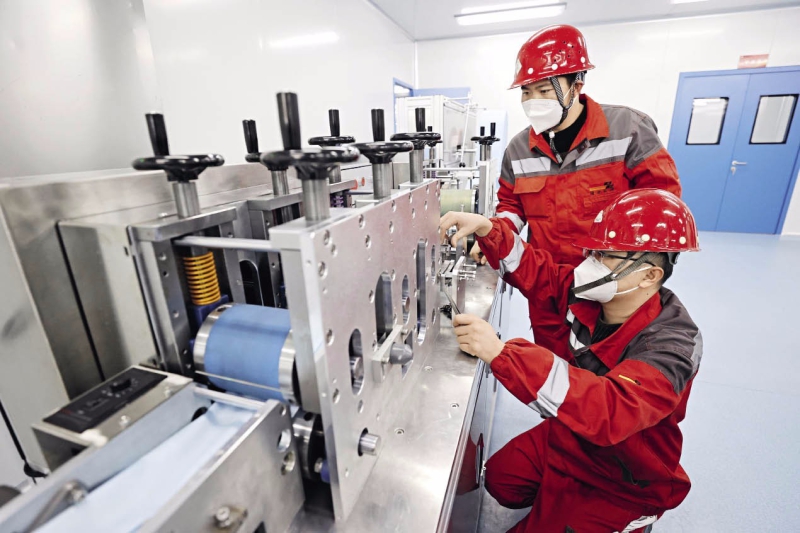___________
The basic economic variables that determine the long-term course of economic growth determine the economic fundamentals. From a macro perspective, these factors are mainly supply factors and their combinations, including labor, land, capital, and innovation. To analyze the fundamentals of a country’s economy, you must look at the total size and combined structure of these elements.
Advantages from a Solid Foundation
On the whole, since the founding of the People’s Republic of China, especially since its reform and opening-up began, China has built a relatively solid material foundation, and its composite national strength has ranked at the forefront of the world. China is the second largest economy in the world, the largest country in manufacturing and trade in goods, and the second largest country in commodity consumption and influx of foreign capital. Its foreign exchange reserves have ranked first in the world for many years. In short, a massive economic foundation has been laid.
From the perspective of supply, China has the most complete and largest industrial supply system in the world, and is also the only country to have all industrial categories in the UN’s International Standard Industrial Classification of All Economic Activities. This complete modern industrial system enables China’s industrial sector to have strong supporting capabilities, which can ensure that the economy will still have great tenacity when it is affected by uncontrollable external factors. In close step with China’s rapid industrialization, its manufacturing industry continues to grow and expand, and more than 230 countries and regions in the world can see the inscription on products, “Made in China.” In 2010, China became the world’s largest manufacturing country in terms of output.

From the perspective of demand, China, with a population of 1.4 billion people, has a large-scale and diverse domestic consumer market. Its per capita GDP has reached US $10,000, and its middle-income group is the largest in the world. A super large-scale consumer market can form a super large-scale domestic demand, which is a huge potential for the long-term growth of China’s economy.
The epidemic has not changed the determinants of China’s long-term economic trajectory. First, the advantage of a large-size economy cannot be changed by the short-term impact from the epidemic. This advantage provides China with a solid foundation to mobilize social resources in response to the impact of the epidemic and promote the return of the economy to a normal state.
Second, the impact of the epidemic can neither change the total scale of factors of production nor the combination of these factors, and therefore cannot undermine the driving force for long-term economic growth. China’s economic structure is being increasingly optimized by the continuous improvement of the efficiency of factor combinations. This is the result of market-oriented reforms and technological innovation, and no fundamental changes will occur as a result of the epidemic.
Third, the basic socialist economic system not only reflects the strengths of the socialist system, but also is compatible with the level of development of social productive forces in the primary stage of Chinese socialism. The impact of the epidemic will not change the advantages of this system. And in the practice of coordinating epidemic prevention and control with economic and social development, China will further adhere to and improve this basic economic system, continuously improve the economy’s ability to resist risks, and increase the resilience of economic development.
Turning Pressure into Power
The most direct blow China’s economy has received from the epidemic is the suppression of the demand for consumer services, and along with that is the onslaught on labor-intensive industries whose production requires collective collaboration. These shock waves will further extend to the entire industrial and supply chains and have a certain inhibitory effect on short-term investment.
However, historically speaking, sudden changes in socio-economic environments such as disasters and wars often become opportunities to promote technological, institutional, and management innovations. The impact of the epidemic will lead to the emergence of more new industries and new business models and accelerate the maturity of other new industries and business models.
In 2018, the value created by China’s new industries and new business models accounted for 15.7 percent of its GDP. As a result of the outbreak of the epidemic, the proportion of those industries will continue to increase. For example, the socio-economic demand for digital technology will expand, including the demand for online medical and health services, community governance, education, shopping, and intelligent production of manufacturing enterprises. All this will promote the digital transformation of enterprises and the economy, and help promote the industry’s upgrade to information- and intelligence-based operation. This will also drive investment in the construction of digital and intelligent infrastructure, which will inevitably further accelerate the transformation of China’s economic growth drivers.
The country has issued a series of short-term policies to reduce the financial burden on enterprises, including cost reduction measures in taxation, finance, social insurance, logistics as well as many other aspects. After conducting trials during the epidemic period, some of those proven effective will be converted into long-term policies. This can promote the deepening of supply-side structural reforms, thereby promoting long-term stable growth of the economy.

Unleashing Development Potential and Momentum
The sector that has been hit hard by the epidemic is the consumer service industry and small and medium-sized enterprises (SME). The government is taking a multipronged approach to provide targeted support and assistance to them. First of all, in terms of epidemic prevention and control, China will increase public welfare support for consumer services and SMEs, improve their epidemic prevention capabilities, and help them to resume operation as soon as possible while ensuring safety. Second, these industries and enterprises are encouraged to adopt new business models and develop online and personalized service models as innovatively as possible. Third, China will give full play to the role of public platforms and large platform enterprises in supporting services to SMEs, reduce the operating costs of SMEs, and make things more convenient for them. Finally, the country will provide a package of policy assistance from various aspects including finance, taxation and social insurance. In addition, a large number of manufacturing companies now need to resume production and work. Even if these enterprises can get back their employees, if their suppliers have not been back to work, it is still impossible for them to resume production. Therefore, the tasks of managing the industrial chain at a macro level and unclogging it are very critical.
The year 2020 is crucial for China. This year China will finish building a moderately prosperous society in an all-round way and complete its 13th Five-Year Plan. This year will also be decisive in China’s fight against poverty. The impact of the epidemic has indeed increased the difficulty of realizing the economic and social development goals in these aspects as scheduled. In this context, it is even more important for China to do a good job in achieving the “six stabilities,” that is, to stabilize employment, finance, foreign trade, foreign investment, domestic investment, and expectations.
To stabilize expectations is the key to realizing the other five stabilities. First, a series of correct decision-making and deployment by the central leadership has played a key role in the prevention and control of the epidemic. As the effect of the measures continues to appear, the expectations for economic development will gradually stabilize.
Second, the government has adopted a proactive fiscal policy, the prudent monetary policy has become more flexible, and effective countercyclical adjustments have been implemented, all of which have played an important role in stabilizing expectations.
Third, the impact of the epidemic is short-term, mainly affecting the economic growth in the first quarter. For this reason, since the fundamentals of the long-term growth of the Chinese economy have not changed, from the perspective of an annual cycle, there is sufficient time to hedge the negative short-term impact of the epidemic. The business environment is expected to improve further after the epidemic, which will have a positive effect on the expected stability of the economy. Based on the expected stability, the implementation of a series of policy combinations that stabilize employment, finance, foreign trade, foreign and domestic investment will surely be able to do a good job in guaranteeing the “six stabilities.” The goal of building a moderately prosperous society in an all-round way and winning the battle against poverty can be achieved on schedule.
___________
HUANG QUNHUI is director of the Institute of Economics of the Chinese Academy of Social Sciences.